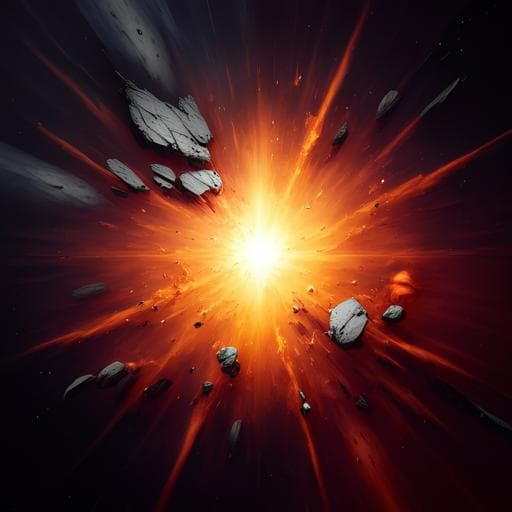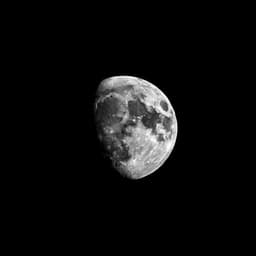
Space Sciences
Evidence of a 4.33 billion year age for the Moon's South Pole-Aitken basin
K. H. Joy, N. Wang, et al.
Uncover the secrets of the Moon's South Pole-Aitken basin! Research by K. H. Joy and colleagues reveals a surprising formation age of 4.32–4.33 billion years, challenging our understanding of lunar bombardment and suggesting a more complex early history of the Moon.
~3 min • Beginner • English
Introduction
The lunar surface preserves scars from intense bombardment by asteroids, comets and planetesimals before 3.8 Ga, forming giant basins and craters and redistributing ejecta. Establishing the timing and sequence of basin formation constrains early Solar System dynamics. The South Pole–Aitken (SPA) basin (~2,000 × 1,500 km inner ring) is the largest recognizable impact structure on any terrestrial body and likely excavated lower crust to upper mantle, producing a voluminous impact melt sheet that differentiated into diverse igneous-like rocks. SPA influenced farside crustal evolution and may have induced nearside partial melting. Although recent missions (Chang’e-4 in situ analyses; Chang’e-6 sample return) target SPA, its formation age remains poorly constrained. Some lunar meteorites have been tentatively linked to SPA by composition. The meteorite Northwest Africa (NWA) 2995 has been proposed as SPA-derived. This study tests that hypothesis by comparing NWA 2995 chemistry with SPA surficial lithologies and dating its mineral/rock components to constrain the SPA basin age.
Literature Review
Prior work establishes heavy early lunar bombardment and debates the chronology of major basins (Imbrium ~3.92 Ga; Serenitatis ~4.1–4.25 Ga; Nectaris; Crisium; SPA potentially oldest). Crater size-frequency and GRAIL-based studies have suggested SPA ages ranging from ~4.26 Ga to >4.33 Ga. Compositional mapping (Lunar Prospector gamma-ray, LRO datasets) defines the SPA central compositional anomaly (SPACA) and surrounding annulus. Several brecciated lunar meteorites of intermediate FeO have unusual chemistries consistent with farside, non-mare terranes, and some have been tentatively linked to SPA. Chang’e-4 rover investigations reported mafic impact-melt lithologies in SPA, and Chang’e-6 returned samples from the basin floor. Apollo highland suites include silicic, evolved rocks (e.g., quartz monzodiorite/monzogabbro; evidence for silicate liquid immiscibility) analogous to evolved clasts observed in some meteorites. However, direct, precise radiometric constraints on SPA formation from SPA-derived materials have been lacking.
Methodology
Sample: A 1.0 × 0.7 cm polished section of lunar meteorite NWA 2995 (regolith breccia) from the former Northern Arizona University collection was studied. Petrography and mineral chemistry: SEM (FEI XL30 FEG-ESEM, Quanta 650 FEG-ESEM, Zeiss Merlin FEG-SEM, JEOL EPMA 8530F) was used to acquire BSE images and element maps at 20 kV. False-color element maps were generated (ImageJ; Photoshop) to identify clasts/phases. Electron probe microanalysis (JEOL JXA-8230; detection limits <0.05 wt%; totals 98–102%) determined mineral/glass compositions; Ti in SiO2 measured on Cameca SX100 (25 kV, 60 nA, 5 µm beam; detection limit ~2.4 µg g−1). Cathodoluminescence: Whole-sample cold-CL imaging (CITL 8200 mk3); zircon CL imaging on JEOL-EPMA 8530F (10 kV, 20 nA). EBSD: Zircons #21 and #44 analyzed at University of Portsmouth (Zeiss Evo10MA, Oxford nano EBSD; 20 kV, 2 nA; 100–300 nm step) to assess crystallinity, strain, and potential reidite. Raman spectroscopy: Horiba Xplora Plus (532 nm laser) collected spectra on zircon and silica phases; peak positions calibrated and assessed for polymorphs and radiation damage/metamictization. Geochronology: SIMS U–Pb and Pb–Pb dating employed CAMECA IMS-1280 instruments. In Beijing: Ca-phosphates (apatite, merrillite) dated in mono-collection mode using O− primary beam (~14 nA, ~15 × 10 µm; 12 cycles ~19 min), measuring 204Pb, 206Pb, 207Pb, 208Pb, 232Th16O, 238U16O, 232Th16O2, 238U16O2; calibrated with NW-1 apatite; common Pb corrected assuming terrestrial 207Pb/206Pb = 0.836. Zircon Pb–Pb dating used <5 µm beam (0.4 nA O primary), measuring 180Hf16O, 94Zr216O, 204Pb, 206Pb, 207Pb (10 cycles ~10 min); accuracy monitored with Phalaborwa baddeleyite; common Pb correction as above. In Stockholm (NordSIMS): Zircon U–Pb used O2 primary beam (5 nA; ~10 µm spot with 5 µm raster), single EM detector with mass-switching; common Pb corrected using present-day terrestrial model; Pb/U calibrated against zircon M257 (561 Ma). Pb isotope analyses for granophyre clasts (multi-collector, four EMs; 60 × 20 s integrations) used USGS BCR-2G glass to correct for mass fractionation and detector gains; background measured each cycle; low-count analyses filtered; isochron dates reported at 95% confidence. Provenance analysis: A chi-squared comparison between NWA 2995 bulk composition (SiO2, Al2O3, MgO, FeO, TiO2, CaO, Th, K, U) and Lunar Prospector gamma-ray global maps (rebinned 0.5° per pixel; ~15 × 15 km pixels) generated P-index maps indicating regions with compositions most similar to NWA 2995; geological context and surface ages of ROIs assessed using USGS geologic maps, crater counts, and stratigraphy.
Key Findings
- NWA 2995 is a regolith breccia containing diverse clasts including quartz–monzogabbro/monzodiorite-like granophyres (QMG), anorthositic gabbronorites, non-mare mafic clasts, granulitic breccias, exsolved pyroxenes, silica- and K-rich phases, and phosphates. Mineral chemistries support a lunar origin and indicate evolved silicic lithologies with exsolved pyroxenes equilibrated at ~748–786 °C.
- Bulk composition: FeO 9.75 wt% (intermediate between feldspathic and basaltic), Th 1.55 µg g−1; atypical compared with nearside KREEP-rich terrains and consistent with farside, non-mare crust.
- Geochronology:
• Zircon U–Pb (Stockholm): upper intercept 4,330.6 ± 3.5 Ma (n = 12 analyses on 5 grains; 90–110% concordance; MSWD 1.10; probability 0.36). Weighted mean 207Pb/206Pb date 4,331 ± 3 Ma (n = 12; MSWD 1.07).
• Zircon Pb–Pb (Beijing): weighted mean 207Pb/206Pb date 4,334 ± 9 Ma (n = 15; MSWD 3.2).
• Ca-phosphates U–Pb (Beijing): discordia upper intercept 4,317 ± 12 Ma; lower intercept 142 ± 71 Ma (n = 13 on 11 grains; MSWD 1.01); three points excluded for Pb loss.
• Granophyre clast Pb–Pb isochron (clast 4; phases: K-feldspar, pyroxene, silica, apatite): 4,317 ± 12 Ma (15 of 17 analyses; MSWD 1.16); two analyses excluded for terrestrial contamination; additional clasts (3, 4b, 8) consistent with same isochron and initial Pb.
- No evidence for the Imbrium (3.92 Ga) thermal overprint in any isotopic system; some minor phosphate disturbances between 3.4–4.0 Ga and a young phosphate reset at 142 ± 71 Ma likely marking regolith breccia formation.
- Zircon EBSD and Raman show variable radiation damage, high strain, and recrystallization features without reidite, consistent with shock-related resetting.
- Provenance mapping: Highest P-index matches for NWA 2995 occur within the SPA basin central floor. Only two ROIs with P ≥ 0.5 have Pre-Nectarian surface ages consistent with 4.32–4.33 Ga dates; both lie SW of Cabannes crater (60.9° S, 169.6° W), on the boundary between SPACA and the Mg-rich pyroxene annulus within the SPA central depression.
- Interpretation: Consistent 4.32–4.33 Ga ages across zircon, phosphates (upper intercept), and Pb–Pb isochrons reflect a single major event resetting/closing chronometers, interpreted as the SPA basin-forming impact.
- Implications: SPA formed ~120 Myr before the main cluster of lunar basin-forming events (~4.2–3.8 Ga), weakening support for a narrow “terminal cataclysm” at ~3.9 Ga and suggesting earlier basins (>4.33–4.5 Ga) were erased by SPA-induced global resurfacing or other processes.
Discussion
The concordant ages from multiple minerals and methods (~4.32–4.33 Ga) most plausibly reflect a basin-scale event that reset U–Pb and Pb–Pb systems, rather than primary crystallization ages variably preserved. Zircon is more resistant to Pb loss than Ca-phosphates; the observation that zircon and phosphates yield similar ancient ages, coupled with deformation and recrystallization features in zircon, supports impact-related resetting. The absence of a 3.92 Ga signature excludes Imbrium heating. The measured ages predate Serenitatis (~4.1–4.25 Ga) and imply an SPA age at the older end of crater-counting estimates (≥4.31–4.33 Ga). Compositional chi-squared matching ties NWA 2995 to the SPA basin floor near Cabannes crater, consistent with Pre-Nectarian surface ages and regolith context. The evolved QMG clasts likely formed via silicate liquid immiscibility at shallow depths and may represent differentiated SPA impact melt products, potentially contributing to the modest KREEP/Th signature in the SPA central zone. Collectively, the chronological and provenance evidence indicates SPA initiated the lunar basin-forming epoch, predating the main basin cluster by ~120 Myr, favoring an accretion tail or saw-tooth impact flux rather than a sharp late heavy bombardment cataclysm. The inferred early SPA age also necessitates that any older basins left little or no surface expression, likely erased by SPA-triggered global resurfacing or crustal relaxation processes.
Conclusion
Geochemical provenance analysis and high-precision SIMS U–Pb and Pb–Pb geochronology of minerals and clasts in lunar meteorite NWA 2995 indicate that it derives from the SPA basin floor and records a basin-forming age of ~4.32–4.33 Ga. This age predates the main period of lunar basin formation (4.2–3.8 Ga) by ~120 Myr, challenging a narrow late heavy bombardment scenario and implying erasure of older basins. The evolved QMG lithologies likely represent differentiated SPA impact melt products. Future work should aim to confirm this SPA age with direct dating of returned SPA materials (e.g., Chang’e-6 south of Apollo basin) and broaden sampling across the SPA floor (e.g., Endurance-A rover concept), coupled with detailed geologic mapping and crater chronology calibration back to ≥4.3 Ga.
Limitations
- The provenance link relies on statistical compositional matching to global gamma-ray maps and regolith averaging; while strong, it remains indirect without in situ context from the exact source region.
- Some isotopic datasets show evidence of Pb loss or terrestrial contamination requiring data filtering and common Pb corrections; phosphate U–Pb is discordant with a young lower intercept.
- Dating reflects the timing of isotopic resetting/closure; interpreting this as the exact impact time assumes complete and rapid resetting across phases.
- Crater-counting surface ages used to assess ROI stratigraphy carry model-dependent uncertainties.
- The study analyzes a single meteorite sample; broader sampling from SPA is needed to generalize results and test spatial variability.
Related Publications
Explore these studies to deepen your understanding of the subject.







